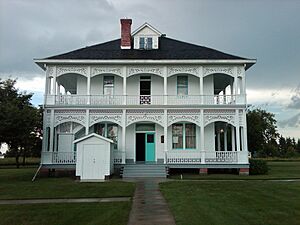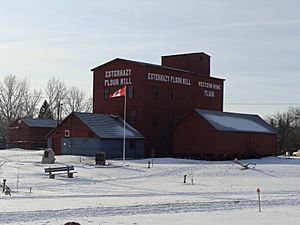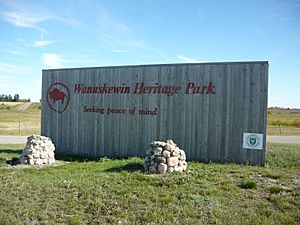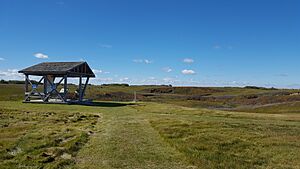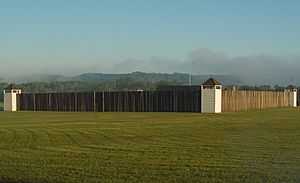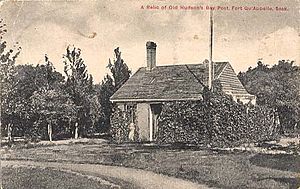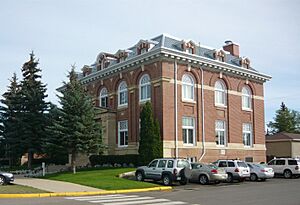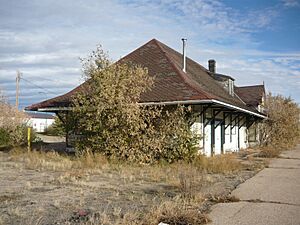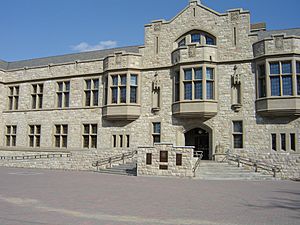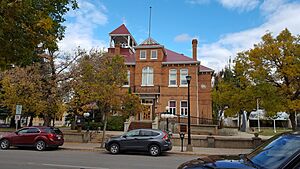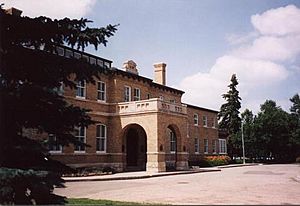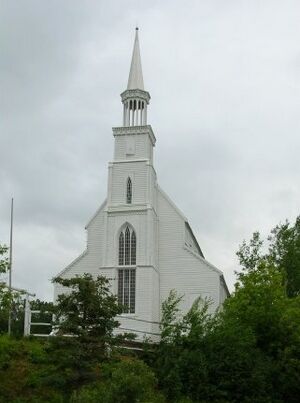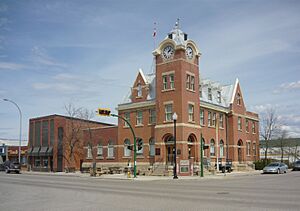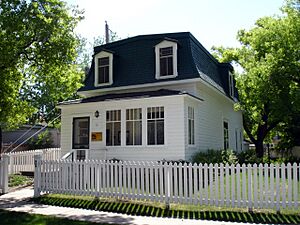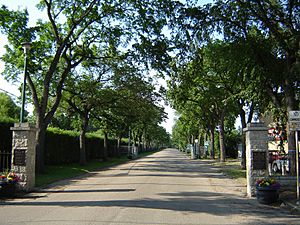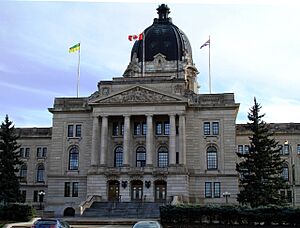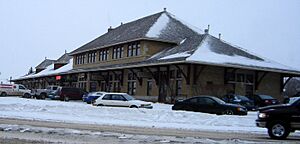List of National Historic Sites of Canada in Saskatchewan facts for kids
This is a list of National Historic Sites (French: Lieux historiques nationaux) in the province of Saskatchewan. These special places are recognized by Canada for their important history. As of July 2021, there were 49 National Historic Sites in Saskatchewan. Ten of these are looked after by Parks Canada (you'll see a beaver icon ![]() next to them).
next to them).
Besides these sites, many important historical events and people are also remembered across Saskatchewan. They are marked with special plaques, just like the sites. Sometimes, a plaque might mark an event or a person, even if it looks similar to a site marker. For example, the Rideau Canal is a Site, but the Welland Canal is remembered as an Event. The names used here are the official ones given by the national Historic Sites and Monuments Board.
Contents
- Exploring Saskatchewan's Historic Treasures
- Sites of Early Life and Settlement
- Important Battle and Conflict Sites
- Historic Forts and Trading Posts
- Cool Buildings and Landmarks
- Battleford Court House
- Biggar Railway Station (Grand Trunk Pacific)
- Canadian Bank of Commerce (Watson, Saskatchewan)
- Claybank Brick Plant
- College Building (Saskatchewan)
- Former Muscowequan Indian Residential School
- Former Prince Albert City Hall
- Government House (Saskatchewan)
- Gravelbourg Ecclesiastical Buildings
- Holy Trinity Anglican Church (Stanley Mission, Saskatchewan)
- Humboldt Post Office
- John and Olive Diefenbaker Museum
- Keyhole Castle
- Marr Residence
- Melville Railway Station
- Moose Jaw Court House
- Next of Kin Memorial Avenue
- Old Government House / Saint-Charles Scholasticate
- Saskatchewan Legislative Building and Grounds
- Saskatoon Railway Station (Canadian Pacific)
- Other Important Sites
- Images for kids
- See also
Exploring Saskatchewan's Historic Treasures
Saskatchewan is full of amazing places that tell stories about Canada's past. From old forts to unique buildings and important battlegrounds, these sites help us understand how the province grew and changed.
Sites of Early Life and Settlement
These places show us what life was like for the first people and settlers in Saskatchewan.
Addison Sod House
The Addison Sod House was completed in 1911 near Kindersley. It's a very rare and well-preserved example of a sod house. These homes were built using blocks of earth and were common on the prairies when settlers first arrived.
Doukhobor Dugout House
Built in 1899 near Blaine Lake, the Doukhobor Dugout House is the only known surviving example of a dugout house. Many early settlers, including the Doukhobor people, lived in these simple shelters dug into the ground when they first came to Canada.
Doukhobors at Veregin
The community of Veregin became the main center for the Doukhobor settlements in the region after 1905. It was important for their administration, distribution, and spiritual life. A large prayer house is a key part of this site.
Esterhazy Flour Mill
The Esterhazy Flour Mill was completed in 1907 in Esterhazy. It's a rare and complete example of a flour milling complex. Flour mills were super important for the grain industry in Saskatchewan and helped farming communities like Esterhazy grow.
Motherwell Homestead
The Motherwell Homestead near Abernethy was established in 1882. It's a farm with a two-storey stone farmhouse. This site is special because it shows what a typical prairie farm looked like during the settlement of Western Canada. It's also connected to William Richard Motherwell, an important figure in farming.
Seager Wheeler's Maple Grove Farm
Established in 1898 near Rosthern, Seager Wheeler's Maple Grove Farm was owned by Seager Wheeler, a famous farmer and seed breeder. This farm shows what a prairie farm was like between 1898 and 1940 and highlights Wheeler's important work in developing new seeds.
Wanuskewin Heritage Park
Wanuskewin near Corman Park has archaeological sites that are nearly 6,000 years old! It tells the story of the Northern Plains peoples who lived along the South Saskatchewan River. It's a special place for learning about Indigenous history.
Important Battle and Conflict Sites
These sites remember key moments of conflict and peace in Saskatchewan's history.
Batoche
Batoche ![]() was a Métis community and the site of the 1885 Battle of Batoche. It remembers both the North-West Rebellion and the unique way Métis people used river lots for their land.
was a Métis community and the site of the 1885 Battle of Batoche. It remembers both the North-West Rebellion and the unique way Métis people used river lots for their land.
Battle of Cut Knife Hill
The Battle of Cut Knife Hill happened in 1885 near Cut Knife. Here, 300 government troops attacked but were pushed back by members of the Poundmaker Cree Nation, led by Pitikwahanapiwiyin.
Battle of Duck Lake
The Battle of Duck Lake in 1885 was the first battle of the North-West Rebellion. It was an important victory for the Métis.
Battle of Tourond's Coulee / Fish Creek
The Battle of Tourond's Coulee / Fish Creek ![]() in 1885 was a battle between government forces and Gabriel Dumont's Métis and First Nations fighters. It was a big psychological win for the Métis during the North-West Rebellion.
in 1885 was a battle between government forces and Gabriel Dumont's Métis and First Nations fighters. It was a big psychological win for the Métis during the North-West Rebellion.
Cypress Hills Massacre
The Cypress Hills Massacre ![]() happened in 1873 near Maple Creek. It was a sad event where American traders attacked a Nakoda camp, killing several people. This event was one of the first big tests for Canada's law enforcement in Western Canada.
happened in 1873 near Maple Creek. It was a sad event where American traders attacked a Nakoda camp, killing several people. This event was one of the first big tests for Canada's law enforcement in Western Canada.
Frenchman Butte
Frenchman Butte ![]() was the site of the Battle of Frenchman's Butte on May 28, 1885. This battle involved the Wood Cree and the Alberta Field Force during the North-West Rebellion.
was the site of the Battle of Frenchman's Butte on May 28, 1885. This battle involved the Wood Cree and the Alberta Field Force during the North-West Rebellion.
Steele Narrows
Steele Narrows near Loon Lake was the site of the very last fight of the North-West Rebellion in 1885. A group of cavalry led by Sam Steele caught up with a party of Cree led by Wandering Spirit and Big Bear.
Historic Forts and Trading Posts
These sites were once important forts and trading posts, showing the early history of trade and policing in the region.
Fort Carlton
Fort Carlton was established in 1810 near Duck Lake. It was a very important Hudson's Bay Company fort and a North-West Mounted Police post. Treaty 6 was also signed here.
Cumberland House
Cumberland House was established in 1774 near Cumberland House. It was the Hudson's Bay Company's first inland fur-trading post. Saskatchewan's oldest permanent settlement grew around it. Today, only a stone gunpowder house from the 1890s remains.
Fort à la Corne
Fort à la Corne was established in 1753 near Kinistino. This area was the furthest western point of New France and later became the site of several fur trade posts.
Fort Battleford
Fort Battleford ![]() was established in 1876 in Battleford. It was an early North-West Mounted Police post and played a big role during the North-West Rebellion.
was established in 1876 in Battleford. It was an early North-West Mounted Police post and played a big role during the North-West Rebellion.
Fort Espérance
Fort Espérance ![]() near Rocanville is an archaeological site. It's believed to hold the remains of two fur trade forts from the late 1700s and early 1800s. It was the earliest and most lasting post of the North West Company related to the Assiniboine River fur trade.
near Rocanville is an archaeological site. It's believed to hold the remains of two fur trade forts from the late 1700s and early 1800s. It was the earliest and most lasting post of the North West Company related to the Assiniboine River fur trade.
Fort Livingstone
Fort Livingstone ![]() near Pelly is an archaeological site. It was once the first capital of the North-West Territories (from 1876-1877) and had the first North-West Mounted Police barracks in Western Canada.
near Pelly is an archaeological site. It was once the first capital of the North-West Territories (from 1876-1877) and had the first North-West Mounted Police barracks in Western Canada.
Fort Pelly
Fort Pelly ![]() near Pelly is an archaeological site from a Hudson's Bay Company fur trade post. It was the main office for the company's Swan River District for almost 50 years.
near Pelly is an archaeological site from a Hudson's Bay Company fur trade post. It was the main office for the company's Swan River District for almost 50 years.
Fort Pitt
Fort Pitt is an archaeological site with the remains of two Hudson's Bay Company forts. The second fort was burned during the North-West Rebellion.
Fort Qu'Appelle
Fort Qu'Appelle was established in 1864 in Fort Qu'Appelle. It was a major Hudson's Bay Company post for the southern Prairies. Today, one original building remains and serves as a museum.
Fort Walsh
Fort Walsh ![]() was established in 1875 near Merryflat. It was the main headquarters for the North-West Mounted Police from 1878 to 1882.
was established in 1875 near Merryflat. It was the main headquarters for the North-West Mounted Police from 1878 to 1882.
Île-à-la-Crosse
Île-à-la-Crosse was a gathering place for Aboriginal peoples even before Europeans arrived. A trading post was set up here in 1775. It became an important supply depot for both the North West Company and the Hudson's Bay Company.
Cool Buildings and Landmarks
Saskatchewan has many historic buildings that show off different styles of architecture and important moments in the province's development.
Battleford Court House
The Battleford Court House was completed in 1909 in Battleford. This three-storey brick and limestone building is a great example of the public buildings built by the provincial government after Saskatchewan became a province in 1905.
Biggar Railway Station (Grand Trunk Pacific)
The Biggar Railway Station (Grand Trunk Pacific) was completed in 1910 in Biggar. This train station shows how important the Grand Trunk Pacific Railway was in developing Western Canada. Its unique design also adds to Canada's architectural history.
Canadian Bank of Commerce (Watson, Saskatchewan)
The Canadian Bank of Commerce was completed in 1907 in Watson. This two-storey wooden bank, now a museum, is the largest surviving example of prefabricated banks. These banks were built quickly in railway towns across the prairies as big banks expanded into Western Canada.
Claybank Brick Plant
The Claybank Brick Plant was established in 1912 in Claybank. It was a factory that made clay bricks from 1914 to 1989. Many of the original buildings and brick-making machines from 1912-1937 are still there and in great condition.
College Building (Saskatchewan)
The College Building was completed in 1912 in Saskatoon. It's the most important and earliest building on the University of Saskatchewan campus. It's part of the best collection of Collegiate Gothic university buildings in Canada.
Former Muscowequan Indian Residential School
The Former Muscowequan Indian Residential School in Lestock was built in 1931 and operated until 1997. It is the last standing Indian boarding school in Saskatchewan and one of the last to close in Canada. This site is important for remembering the history of residential schools in Canada.
Former Prince Albert City Hall
The Former Prince Albert City Hall was completed in 1893 in Prince Albert. This old city hall, with its bell tower, is now an arts center. It's one of the few 19th-century town halls left on the Canadian Prairies and shows the town's importance back then.
Government House (Saskatchewan)
Government House was completed in 1891 in Regina. It used to be the home of the Lieutenant Governor of the North-West Territories. Now, it's used for events, as a museum, and for offices. It's one of the few government buildings from that time that still exists.
Gravelbourg Ecclesiastical Buildings
The Gravelbourg Ecclesiastical Buildings in Gravelbourg include a cathedral, bishop's residence, and convent, with the cathedral completed in 1919. These buildings represent the efforts of the Roman Catholic Church to settle Western Canada with French Canadians in the late 1800s and early 1900s.
Holy Trinity Anglican Church (Stanley Mission, Saskatchewan)
Holy Trinity Church was completed in 1860 in Stanley Mission. This large wooden church on the Churchill River is the oldest existing building in Saskatchewan and the oldest church west of the Red River. Its spire can be seen from far away!
Humboldt Post Office
The Humboldt Post Office was completed in 1912 in Humboldt. This building, designed in the Romanesque Revival style, is still a major landmark on Main Street. It shows how federal services expanded across the west in the early 1900s.
John and Olive Diefenbaker Museum
The John and Olive Diefenbaker Museum in Prince Albert was built in 1912 and bought by the Diefenbakers in 1947. It was the home of former Prime Minister John Diefenbaker and his second wife, Olive. Now it's a museum.
Keyhole Castle
Keyhole Castle was completed in 1913 in Prince Albert. This two-and-a-half-storey mansion is built in the Queen Anne Revival style. Its name comes from the keyhole shape of the windows in its corner tower. It shows the unique and hopeful architecture of the early 1900s.
Marr Residence
The Marr Residence in Saskatoon was built in 1884. It was part of the first European settlement in the area and served as a field hospital during the North-West Rebellion.
Melville Railway Station
The Melville Railway Station was built in 1908 in Melville. This major Grand Trunk Pacific Railway station helped settle and develop the West.
Moose Jaw Court House
The Moose Jaw Court House was completed in 1909 in Moose Jaw. This brick court house has a Beaux-Arts design and Neoclassical details. It represents Saskatchewan's new justice system from 1908.
Next of Kin Memorial Avenue
Next of Kin Memorial Avenue was completed in 1923 in Saskatoon. It's a lane about 0.7 km long, lined with elm trees and bronze plaques, ending in a stone memorial. It's a great example of the "Roads of Remembrance" that were created to honor those who died in the First World War.
Old Government House / Saint-Charles Scholasticate
Old Government House / Saint-Charles Scholasticate in Battleford was completed in 1879. It was the site of the first Government House of the North-West Territories. Sadly, the house was destroyed by fire in 2003.
Saskatchewan Legislative Building and Grounds
The Saskatchewan Legislative Building and Grounds was completed in 1912 in Regina. This beautiful limestone building by Lake Wascana is one of the best examples of Beaux-Arts and City Beautiful design in Canada. It's a strong symbol of Saskatchewan's ambition and spirit.
Saskatoon Railway Station (Canadian Pacific)
The Saskatoon Railway Station (Canadian Pacific) was completed in 1908 in Saskatoon. This two-storey, Château-style railway station remembers the Canadian Pacific Railway and the smaller stations built during its busy years.
Other Important Sites
Gray Burial Site
The Gray Burial Site near Swift Current is one of the oldest burial sites on the Canadian Prairies, dating back to around 3000 BCE. It's a rare example of an Aboriginal burial ground, containing the remains of about 154 individuals, showing different burial methods.
Last Mountain Lake Bird Sanctuary
The Last Mountain Lake Bird Sanctuary was established in 1887 near Last Mountain Valley. It was set aside to protect wildfowl and was the first reserve of its kind on the continent!
Forestry Farm Park and Zoo
The Forestry Farm Park and Zoo in Saskatoon was established in 1913. It started as a tree nursery and model farm to develop new and scientific farming methods. Today, it's a municipal zoo.
Montgomery Place, Saskatoon
Montgomery Place in Saskatoon was established in 1945. It was a community built for veterans after World War II and has become a special historic district.
Images for kids
See also


